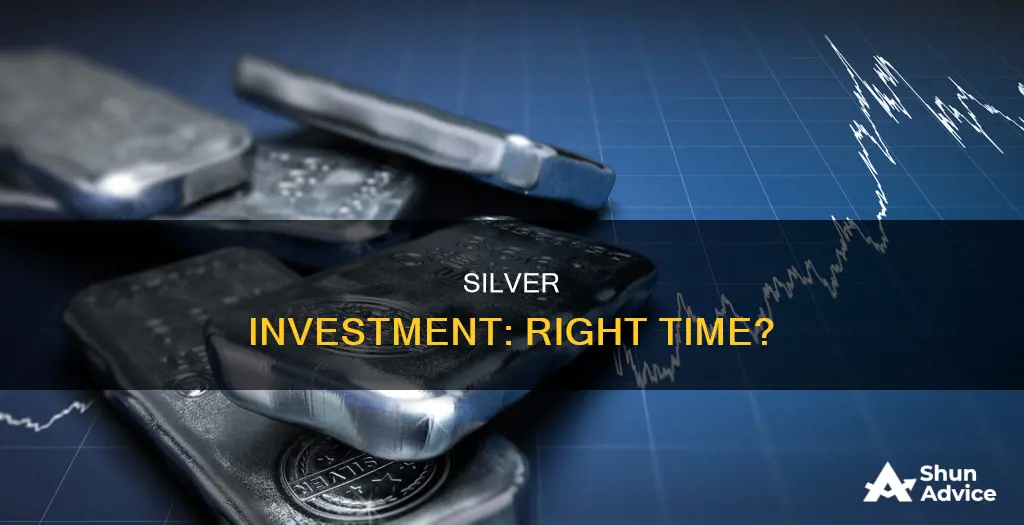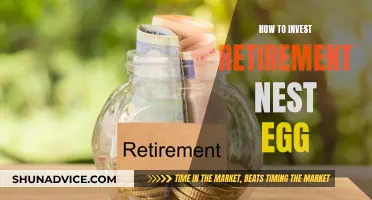
Silver is a precious metal that has been used as legal tender for thousands of years. It is often viewed as a safe-haven asset, similar to gold, and investors tend to flock to it during times of economic or political turmoil. Silver is also used in industrial applications, such as electronics, solar panels, batteries, and automotive manufacturing.
There are several ways to invest in silver, each with its own risks and rewards. Here are some of the most common methods:
- Owning physical silver, such as coins or bullion
- Silver futures and options
- ETFs that own physical silver or silver futures
- Silver mining stocks
- ETFs that own silver miners
When deciding whether to invest in silver, it is essential to consider the current economic climate, industrial demand, inflation rates, and the gold/silver ratio. Silver tends to be a volatile investment option, and its price can fluctuate significantly over short periods. However, it can provide a hedge against economic turmoil and inflation, making it a valuable addition to a well-diversified investment portfolio.
| Characteristics | Values |
|---|---|
| Volatile | Silver is a volatile investment, but this volatility can work in an investor's favour. |
| Safe-haven asset | Silver is often seen as a safe-haven asset, similar to gold, that can protect investors in times of uncertainty. |
| Finite tangible asset | Silver is a finite tangible asset, meaning it has inherent and real value. |
| Cheaper than gold | Silver is significantly cheaper than gold, making it more accessible to investors. |
| Higher returns than gold | Silver has outperformed gold in bull markets and tends to move in tandem with gold. |
| Long history | Silver has been used as legal tender for thousands of years, lending it stability. |
| Theft | Holding physical silver can leave investors vulnerable to theft. |
| Poor return on investment | Silver may not perform as well as other investments, such as real estate or mining stocks. |
| High demand leads to higher premiums | High demand for physical silver can lead to higher premiums, making it a less attractive investment. |
| Lack of liquidity | Silver bullion coins are not legal tender and may be difficult to sell in a hurry. |
| Industrial demand | Silver has numerous industrial applications, including in electronics, solar panels, batteries, and automotive manufacturing. |
| Inflation hedge | Silver is a hard asset that can preserve wealth during times of high inflation. |
| Gold/silver ratio | The current gold/silver ratio is above 80, indicating that gold is about 80 times more expensive than silver. Historically, the ratio has averaged in the 50s. |
| Portfolio diversification | Silver provides valuable diversification benefits as its prices do not move in perfect correlation with other assets like stocks and bonds. |
What You'll Learn

Silver's limited supply and high demand
Silver is a precious metal with a range of applications, from industrial fabrication to investment. Its unique properties make it a highly sought-after commodity, and its limited supply and high demand dynamics can have a significant impact on its value.
Silver has been recognised for its value throughout history, serving as legal tender for thousands of years. Today, it is still considered a safe-haven asset, similar to gold, that investors turn to during uncertain times or to hedge against inflation.
On the supply side, silver is a finite resource with constrained mining output. Falling production in historically significant mining countries, such as Mexico, contributes to the limited supply of silver.
Meanwhile, the demand for silver remains robust and is projected to increase. Silver's excellent electrical and thermal conductivity make it a key component in various industrial applications, including electronics, solar panels, and the automotive industry. The push towards renewable energy and electrification further drives the demand for silver.
Additionally, silver is used in jewellery and silverware, which account for a significant portion of global demand. Investment demand for silver also plays a crucial role, with investors seeking exposure to the metal through physical bullion, coins, or investment vehicles such as exchange-traded funds (ETFs).
The combination of limited supply and high demand can result in a market deficit for silver, as seen in projections by the Silver Institute for 2023. This deficit can lead to a rapid increase in silver prices, making it an attractive investment opportunity for those who want to take advantage of its potential upside.
In conclusion, silver's limited supply and high demand dynamics make it a valuable commodity with the potential for significant price appreciation. Investors seeking exposure to precious metals or those looking to hedge against economic uncertainties may find silver an appealing investment option.
Unlocking Private Equity: Investors' Perspective
You may want to see also

Silver's industrial applications
Silver is an essential component in many industries due to its unique properties, including its high electrical and thermal conductivity, reflectivity, and antibacterial qualities. It is used in a wide range of applications, from electronics to medicine, and is an integral part of the push towards renewable energy.
Electronics
Silver is a key component in the production of almost every electronic device, including computers, mobile phones, automobiles, and appliances. Its high electrical conductivity and durability make it the perfect substance for coating electrical contacts and creating electrical pathways. For example, Radio Frequency Identification Devices (RFID) chips, which are replacing barcodes in supermarkets and supply chain inventories, use silver in their paper-thin antennas. Silver is also used in printed circuit boards, membrane switches, conductive adhesives, and the preparation of thick-film pastes.
Solar Panels
Silver's sensitivity to light and high electrical conductivity have made it an essential component in the photovoltaic or solar energy industry. Silver is used as a conductive ink in photovoltaic cells, which transform sunlight into electricity. These cells are then combined to form solar panels. Silver's reflective qualities also make it useful in the generation of solar power.
Automotive Industry
Silver is used in various automotive applications, including electrical contacts, microprocessors, memory and circuit boards, and radar and camera sensors. Silver-coated contacts activate every electrical action in a modern car, from starting the engine to opening power windows. Battery electric vehicles contain more silver than conventional vehicles, and the push towards electrification is expected to increase silver demand from the automotive sector.
Brazing and Soldering
Silver is commonly used in brazing and soldering, helping to produce smooth, leak-tight, and corrosion-resistant joints when combining metal parts. Silver-brazing alloys are widely used in air conditioning, refrigeration, and electric power distribution. Silver is also used in the joining of copper pipes, replacing lead-based solders due to lead's toxic properties.
Medicine
Silver has long been recognised for its antibacterial properties, making it valuable in the medical field. It is used in wound dressings, surgical instruments, and water purification systems to prevent infections and promote healing. Silver nanoparticles are also used in textiles to prevent the growth of odour-causing bacteria. Additionally, silver has found applications in nanotechnology, where it acts as an antimicrobial agent, and in the production of medical imaging films for X-rays and radiography.
Invest Wisely: Picking the Right Path
You may want to see also

Silver as a hedge against inflation
Silver is often seen as a good hedge against inflation, but it is a volatile investment. Silver is a precious metal, and its value is derived differently from paper currencies. It cannot be printed, and it has a finite supply. When the US dollar weakens due to increased money supply or inflation, the silver price tends to rise.
Silver has been used as legal tender for thousands of years, and its value has persisted throughout much of human history. It is also used in industrial applications, including in batteries, smartphones, glass coatings, and water filtration.
Silver prices tend to move in tandem with gold prices. When the price of gold rises, so does the price of silver. This is because silver has greater ties to industry than gold, and when demand for goods and services outpaces supply, the price of silver increases.
Silver is also much more affordable than gold, so its price moves faster and can provide a greater return on investment. This makes it a good option for investors looking for an affordable entrance to the precious metals market.
However, silver is extremely volatile, even more so than gold, other commodities, and the S&P 500. Its multiple use categories mean that industrial demand coupled with investment demand can drive prices up or down quickly.
As an investment, silver can be purchased physically as coins or bullion, or through stocks, futures, and exchange-traded funds (ETFs).
Unit Trust: Why Invest?
You may want to see also

Silver's historical performance
Silver has been considered a reliable store of wealth and value for centuries. It has been used as a medium of exchange in many societies and is still recognised as a precious metal today.
Over the very long term, silver's price has outpaced inflation, rising more than 40% since 1915. However, in shorter periods, silver can be volatile. For example, silver bought in 1915 had lost about half of its inflation-adjusted value by 2001.
Silver's performance is influenced by many factors, including industrial supply and demand, central bank monetary policy, inflation, and the performance of stock markets and bonds.
Beanie Babies: A Collectible Craze
You may want to see also

Silver's role in portfolio diversification
Silver is an attractive asset for portfolio diversification due to its unique qualities and diversified uses. Here are some of the roles that silver can play in an investment portfolio:
Hedge Against Inflation
Silver has historically risen in price during inflationary periods, effectively preserving the investor's purchasing power. Its affordability and accessibility compared to other inflation hedges like gold and real estate make it an attractive option for investors looking to diversify their portfolios.
Safe Haven During Geopolitical Instability
Silver, like other precious metals, often acts as a safe-haven asset during times of geopolitical instability. Historical trends show that silver prices tend to increase during such periods, providing investors with a safety net.
Commodity With Industrial Demand
Silver's exceptional conductivity makes it indispensable in various industries, including electronics and solar panels. This industrial demand helps support silver's value and enhances its investment appeal.
Protection Against Currency Fluctuations
Silver, traded globally and priced in US dollars, protects against currency risk. It is a straightforward and tangible solution for managing currency risk, unaffected by the monetary policies of individual countries.
Low Correlation With Other Assets
Silver has historically exhibited a low correlation with mainstream investment assets like stocks and bonds, meaning its price often moves independently of these markets. This low correlation allows silver to act as a counterbalance within an investment portfolio, providing overall stability.
Tangible Asset With Inherent Value
Silver is a physical asset that provides an added layer of security for investors as its value is not solely based on market perception. Its liquidity and divisibility make it a versatile and practical addition to a diversified investment portfolio.
Investments: Where People Put Their Money
You may want to see also
Frequently asked questions
It depends on your financial situation, goals, and risk tolerance. Silver is a good investment when supply and demand are out of balance, so when prices are low and you find a silver company that can take advantage of the situation, that's when you want to buy.
Silver is a safe-haven asset, similar to gold, and can be used to hedge against economic turmoil and inflation. It's also a highly useful industrial commodity, with applications in electronics, solar panels, batteries, and automotive manufacturing.
Silver is subject to high price volatility and may not be the best way to protect your portfolio in the short term. It's also vulnerable to theft if held physically, and there is a danger of overpaying for physical silver.
There are several ways to invest in silver, including buying physical silver (bars or coins), investing in silver futures contracts, purchasing shares of silver mining companies, or buying into exchange-traded funds (ETFs) that focus on silver.







